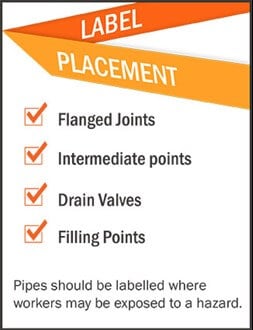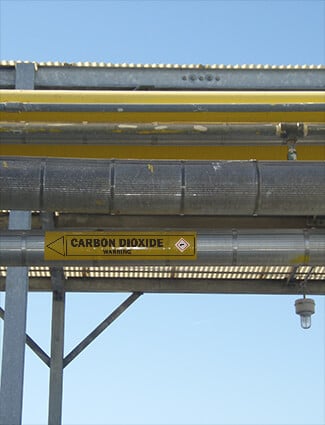BS 1710 British Standard Pipe Marking

British Standard 1710 (BS 1710) provides a robust framework that fulfills the pipe marking requirements set forth in Health and Safety (Safety Signs and Signals) Regulations 1996, as well as other local and regional regulations in the UK. This standard applies to pipes, ducts, and electrical conduits in both above and below ground installations.
This standard provides guidance on label placement, colour coding, and information about pipe contents.
Why Use BS 1710?
New regulations increasingly require a more robust pipe marking scheme to improve safety by communicating essential information about the contents in pipes. BS 1710 has been designed to address these regulations and is especially useful to:
- Building designers and owners
- Service installers
- Gas, liquid fuel, refrigeration, waste, and water industries
In addition, with recent updates to water industry regulations in the UK, following BS 1710 meets the legal requirements for those who install plumbing systems, eliminating many cross-contamination issues.

Always check local regulations to ensure all legal requirements are met.
Pipe Marker Locations
The BS 1710 pipe marking standard applies to pipes carrying fluids that are located above and below ground. It requires that, at a minimum, pipe marking must be located on both sides of valves, service appliances, bulkheads, wall and floor penetrations, as well as any other place pipe contents identification is needed.
Pipe Marker Colours
BS 1710 stipulates specific colours, which are identified by their BS Colour Reference number. These colours are separated into three categories:
- Basic Identification Colours (8 colours)
- Safety Colours (4 colours)
- Code and Other Colors (11 colours)
Decorative or protective coatings on pipes may not use any of these colours.
Basic Identification Colours
| Pipe Contents Name Reference | Colour | BS 4800 Colour |
| Water | Green | 12 D 45 |
| Steam | Silver-Grey | 10 A 03 |
| Oils (mineral, vegetable or animal) | Brown | 06 C 39 |
| Gases (in either gas or liquid phase - except air) | Yellow Ochre | 08 C 35 |
| Acids / Alkalis | Violet | 22 C 37 |
| Air | Light Blue | 20 E 51 |
| Other Liquids | Black | 00 E 53 |
| Electrical Services & Ventilation Ducts | Orange | 06 E 51 |
Safety Colours
The British Standard 1710 Safety Colours are used in addition to the Basic Identification Colours. The basic colour, indicating the pipe contents, is shown on either side of the safety colour. For example, fire fighting water would have a band of green (water), a band of red (fire fighting), and then another band of green. Fire fighting steam would be silver-grey, red, silver-grey.
- Fire Fighting - Red - 04 E 53
- Warning - Yellow - 08 E 51
- Fresh Water - Auxiliary Blue - 18 E 53
Colours may be painted onto pipes or applied using adhesive labels that wrap around the pipe. BS 1710 also allows for user-defined custom colours to provide more detailed information. As when Safety Colours are used, the user-defined colour is located between bands of the required Identification Colours.
Content Information-Code Indications

The British Standard 1710 pipe marking code requires that information about pipe contents be provided using at least one of the following methods:
- The full name
- The common abbreviation of the name
- The chemical symbol
- The refrigerant number as specified in British Standard 4580
- The appropriate colour bands (including specific color coding specified for medical and general building services, and optional colour bands for refrigeration services).
The above Code Indications must be at least at the specified locations for pipe markers, and there must always be a Code Indication next to any banding.
Pipe content names, abbreviations, symbols and numbers must be printed in either black or white, whichever provides the best contrast. The Code Indications are to be placed directly on the pipe or on a label placed on the pipe. The background colour of the label must match the safety identification colour.
Indicating the Direction Of Flow
The direction of the fluid flow in a pipe is to be indicated by an arrow located near the basic Identification Colour. The arrow may be either white or black, whichever provides the best contrast. If a label with the Identification Colour is being used, the direction of flow is indicated by the pointed end of this label.
If Area Does Not Require BS 1710
Pipe marking requirements change based on local and regional regulations. Some regulations may require BS 1710, while others may not. However, even if BS 1710 is not mandated, pipe marking is required in some form. In these situations, it is best to look towards an established standard, like BS 1710, for guidance.
Compliant Pipe Markers
An effective way to follow British Standard 1710 is to use adhesive backed pipe marker labels. Adhesive BS 1710 pipe markers are easy to make and apply. When paired with a DuraLabel Industrial Label Printer, they are economical, durable, and you can get the right material for the conditions specified by BS 1710.
Related Resources

How Sun Exposure Affects Pipe Labels
Pipes serve as the glue to many sectors of the industrial industry by transporting water, oil, chemicals, and ...
Read
Safety that Sticks: Using Pipe Labels for Every Size and Type of Pipe
Proper use of pipe labels in industrial settings is essential for safety, compliance, and operational ...
Read
Pipe Marking Basics: OSHA and ANSI/ASME Labeling Standards
Why Is Pipe Labeling Important for Facility Safety and Efficiency? Pipes can put people and facilities in ...
Read.png)





